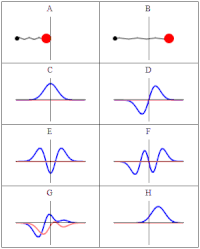
Photo from wikipedia
A magnetic field, through its vector potential, usually causes measurable changes in the electron wave function only in the direction transverse to the field. Here, we demonstrate experimentally and theoretically… Click to show full abstract
A magnetic field, through its vector potential, usually causes measurable changes in the electron wave function only in the direction transverse to the field. Here, we demonstrate experimentally and theoretically that, in carbon nanotube quantum dots combining cylindrical topology and bipartite hexagonal lattice, a magnetic field along the nanotube axis impacts also the longitudinal profile of the electronic states. With the high (up to 17 T) magnetic fields in our experiment, the wave functions can be tuned all the way from a "half-wave resonator" shape with nodes at both ends to a "quarter-wave resonator" shape with an antinode at one end. This in turn causes a distinct dependence of the conductance on the magnetic field. Our results demonstrate a new strategy for the control of wave functions using magnetic fields in quantum systems with a nontrivial lattice and topology.
Journal Title: Physical review letters
Year Published: 2019
Link to full text (if available)
Share on Social Media: Sign Up to like & get
recommendations!